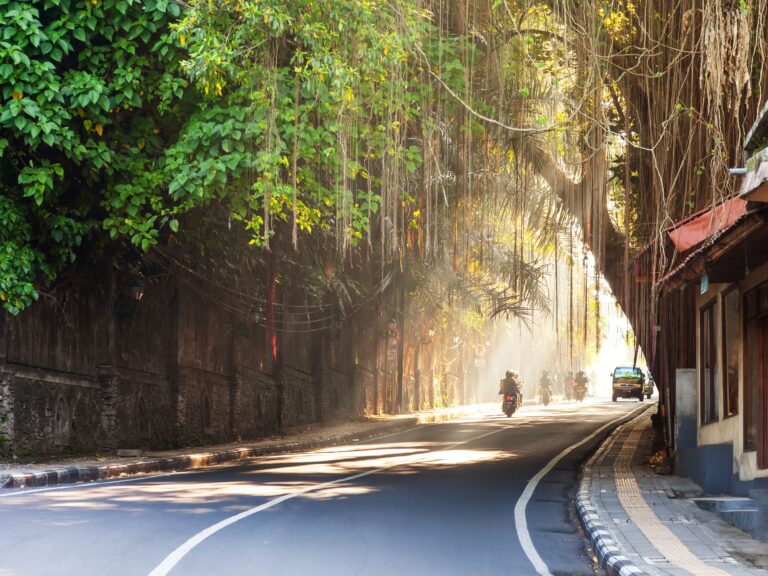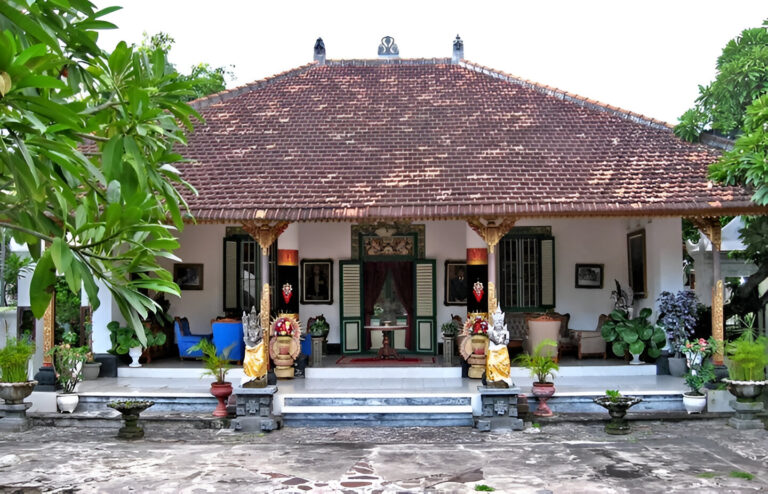Gunung Kawi is one of Bali’s most interesting temple sites and our guide will explain all you need to know about this fantastic place in Bali’s Valley of the Kings.
Where Is Gunung Kawi Temple?
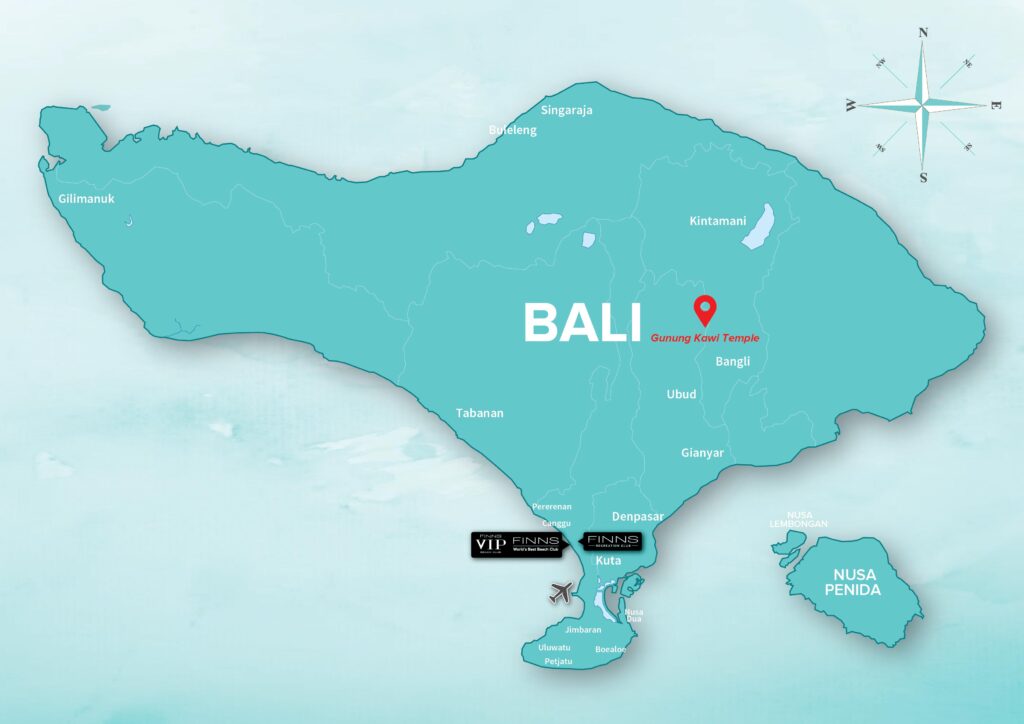
Gunung Kawi is just outside of Ubud in Central Bali.
The address is: Banjar Penaka, Tampaksiring, Gianyar Regency, Bali 80552, Indonesia
How To Get To Gunung Kawi Temple?

Given that this site sits on a lush river valley running through lush paddy terraces of rice, you might prefer to visit it during the rainy season when the rice terraces and rice paddies are at their greenest and most vibrant.
However, it still remains an attractive site all year round.
As with most of the interesting sites in Bali, the earlier in the day you get there, the better. As you are more likely to beat the crowds.
There is no particular advantage to reaching this temple among the rice fields at sunset as the valley hides it from the best of the golden hour light.
What Are The Opening Hours At Gunung Kawi Temple?
The Gunung Kawi temple is open from 8 a.m. to 6 p.m. each day except for the festival of Nyepi and the hours are subject to occasional change based on local uses of the temple.
Is There An Entrance Fee For Gunung Kawi?
There is an entrance fee for Gunung Kawi and it’s a very reasonable 50,000 IDR for adults and 25,000 IDR for children.
This price includes the rental of a sarong cloth to keep you dressed appropriately during your visit.
There is a parking lot and your entry fee includes the use of this facility.
About Gunung Kawi Temple Complex

This site, unlike most other Balinese temple courtyard sites, is a split worship site between Buddhist and Hindu faiths.
This is not particularly unusual in Southeast Asia and the two religions have co-existed throughout much of the region with one or the other eventually assuming the primary position, but never erasing any traces of the other.
Thus, you can find small stone caves near the tombs where Buddhist monks would have come to pray. These meditation sites complement the overall nature of the various shrines on the site.
The courtyard, which lies across the river, however, is laid out in the same way as any other temple courtyard in Bali and contains the temple’s main grand pavilion as well as a bunch of additional shrines.
Keep an eye out for the piodalan festival here which takes place on the third full moon of the Balinese Calendar (Purnama Katiga) when the temple is beautifully decorated by the locals.
Candi
The word “pura” is a common one and it refers simply to a “temple” and in the case of most Balinese temples, “pura” is the only word you really need to know.
However, at the Gunung Kawi Temple, there are ten “candi” present and each candi is meant to provide a home for the soul of an ancient king.
These candi are very similar to other candi found on the island of Java and they’re quite different to the ones normally found here in Bali.
Officially, the word “candi” refers to “an ancient stone building used for worship or for storing the ashes of cremated Hindu or Buddhist kings and priests”
In Bali, the word candi usually refers to a stone/brick-built structure that contains a shrine (with a single cell), a portico, an entrance and a stairway, with a roof in a pyramid design.
It’s also worth noting that a candi does not actually need to be “ancient” in Indonesia and they are regularly renewed or refreshed at some active temple sites (such as at the Alas Purwo site on the island of Java).
The word candi is thought to be an abbreviation of the word “Candika” which is one of the manifestations of the goddess of death, Durga.
This would certainly explain its connection to tombs.
There are two rows of candi, with 5 candi in each, overlooking the Pakerisan River Valley Walls at this site.
The river flows through the center of Gunung Kawi and you can cross from one side of the river to the other side of the river using a bridge.
It’s thought that Gunung Kawi was located on this site because the sacred Pakerisan river will purify the rock shrine complex and keep its occupants safe from harm.
The first row of candi is said to have been built for King Anak Wungsu. King Anak Wungsu would have ruled over Central and East Bali during the period of roughly 1050 AD to 1080 AD.
Why five candi? Well, the theory is that when the ancient kings died, their wives were meant to have killed themselves as part of the mourning ritual!
Thus, it’s possible that the first rock shrine complex here is a tribute to a king and his four dead wives.
However, the history of this temple in Bali is somewhat mysterious and there are various other theories as to who each candi is dedicated to.
Some even theorize that King Udayana and his Queen Mahendradatta are buried here (he ruled about 100 years earlier in 950 AD) or that his son is.
Myths Associated With Pura Gunung Kawi
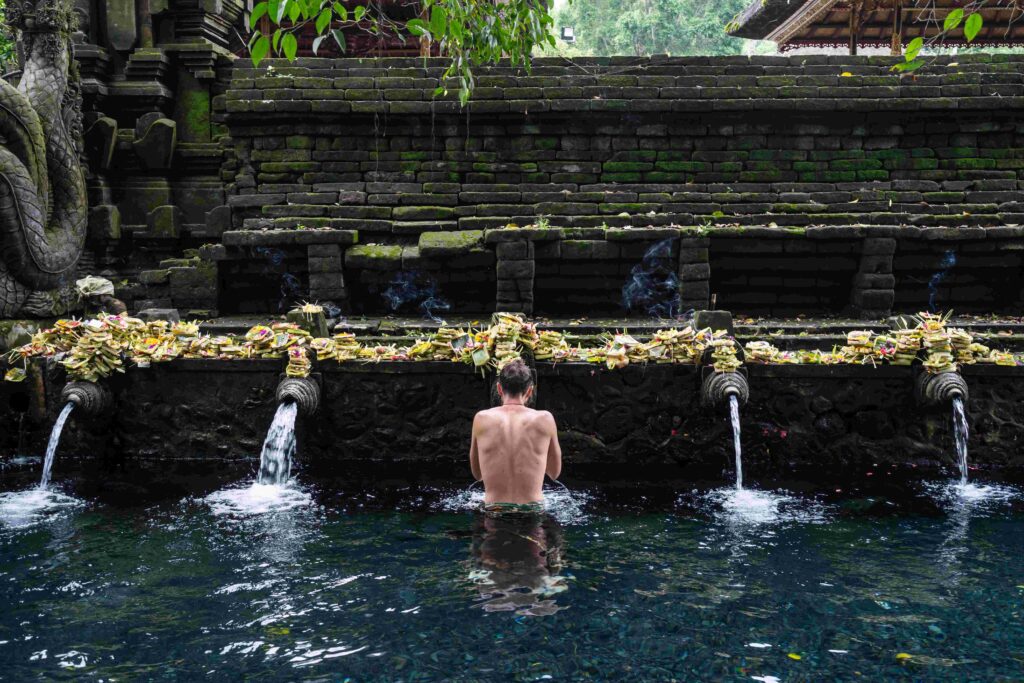
There are plenty of ancient legends and myths regarding the Gunung Kawi Temple and one says that the giant Kebo Iwo arrived on this spot and used his fingernails to carve the tombs out of the solid rock cliff in a single night.
The myth of Kebo Iwo is older than Hinduism in Bali and it’s said that even the great king Udayana and his queen Mahendradatta were afraid of him.
However, he is not associated with any kind of evil and despite his extraordinary feats of strength on the rock face of this exotic setting, he is said to have protected Bali from attack from outsiders using his magic.
Tombs Vs Pura Gunung Kawi
What is certain is that Gunung Kawi was used as a place of worship and as a tomb long before it became a Hindu temple site.
There is an inscription at this site (and only one) that reads “Haji Lumahing Jalu” in the writing of the Kadiri Kingdom. This is a touch problematic for historians as the site appears to date back to the 11th century but the writing was only popularized in the 13th century.
The translation of the inscription simply reads, “The king made a temple here.”
This really doesn’t help a huge amount with determining who made the temple complex and whom the shrines surrounding it are dedicated to.
Gunung Kawi is something of an enigma and thus, one of the more fascinating complexes in Bali. After all, who doesn’t love a mystery?
What Is The History Of The Pura Gunung Kawi Temple Complex?

As we’ve already touched on, nobody is quite certain of the history of Gunung Kawi. Balinese history is often difficult to ascertain, mind you, due to the lack of written records.
The royal family shrines have definitely been there since the 11th century (and possibly even the 10th century), some of the Hindu elements, however, are likely to have been added far more recently.
The whole complex is a product of many centuries of work and care.
Facilities At Gunung Kawi Temple
There are some decent facilities at this temple including some small local warungs near the parking lot where you can stock up on drinks and snacks.
Along the road leading up to the temple (Jalan Raya Gunung Kawi) you can find art shops, souvenir stalls, and the like.
We think that Gunung Kawi Temple is one of the best temples in Ubud.
Tirta Empul Temple
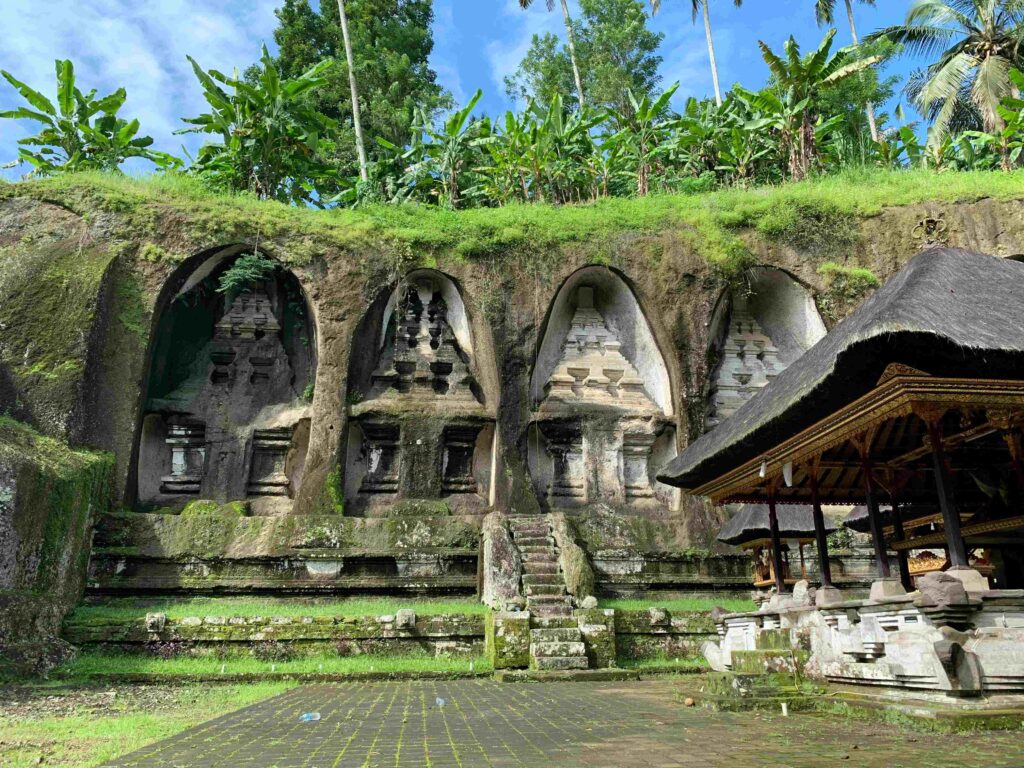
It’s worth noting that the sacred water temple, Tirta Empul, is just a kilometre north of Gunung Kawi.
Thus, if you visit Gunung Kawi, you really should add Tirta Empul to your itinerary.
Gunung Kawi Sebatu
There is also another temple complex with a very similar name just 4.5 kilometers to the northwest of Gunung Kawi.
It’s not a “must-see” but if you’re a completist, it’s a nice place to visit if you’re already in the area.
FAQs
How Old Is Gunung Kawi Temple?
The temple was probably founded in the 11th century, which makes it nearly 1,000 years old. However, its history is not entirely clear and it might even be a century older and thus over 1,000 years old!
The tombs are older than the temple (which is very much in a traditional Balinese Hindu layout) but how much older, exactly, is unknown.
It’s one of the things that makes this temple so appealing to visitors, the sense of mystery about it.
What Do You Wear To Bali Temples?
You must dress modestly in Hindu temples in Bali and Gunung Kawi is no exception. This means you should cover your shoulders and legs. The locals wear a shawl and sarong for this purpose.
The entrance fee at Gunung Kawi includes a sarong rental, so there’s no excuse for wandering around indecently dressed.
We should also point out that women are not meant to enter temple grounds in Bali if they are menstruating as they are considered to be unclean in Hindu lore.
That very much depends on where you are, what you want to see and how much time you have.
Gunung Kawi and nearby Tirta Empul are fantastic, as is Goa Rajah, but if you travel further afield you have the Mother Temple, Pura Ulun Danu Beratan, Tanah Lot, and so many more amazing temple sites in Bali.
We’d love to see every temple on the island though it might take a while as there are an estimated 20,000 temples in Bali!
Final Thoughts On Pura Gunung Kawi
Gunung Kawi is one of Bali’s most interesting and fascinating temple complexes. Given how easy it is to get to from Ubud, it should definitely be on your itinerary if you’re visiting the spiritual heartland of the nation.
Of course, once you’ve had your fill of mountains and temples here in Bali, we hope to see you for a bit of a party at FINNS, the best beach club in the world.






